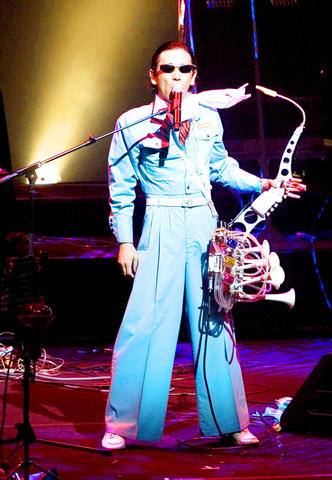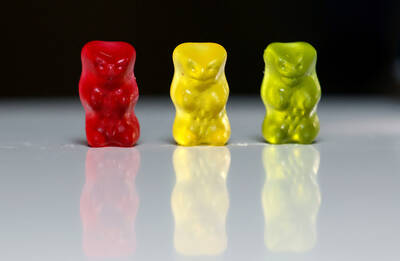The lights dim and a spotlight shines on the lean, bespectacled Japanese man in a blue worker's jumpsuit strapped to a metallic winged device with wires and switches.
Seconds later, in a sci-fi-meets-rock-circus moment, he breaks into a series of hip-twisting, finger-snapping movements that produce a sequence of knocks from the ends of the wings.
Meet Nobumichi Tosa, president of Japanese art outfit Maywa Denki.

PHOTO: AFP
His ensemble of nonsense instruments includes flower-shaped xylophones, singing robots and dancing puppets, all powered by 100 volts of electricity.
Started in 1993, Maywa Denki, which means Maywa's Electric in Japanese, is a fictitious company which Tosa uses as a platform to promote his art.
"Maywa Denki is very famous in Japan, like Sony, Panasonic and Microsoft," Tosa joked to his audience during a recent performance called Mechatronica at Singapore's premier art complex, The Esplanade.
It was a bizarre 80-minute play of technology and mechanics.
Tosa, 40, and three other jumpsuit-clad men, played Japanese ballads and rock songs using home-made instruments, complete with cheesy choreography and Japanese comic kitsch.
Maywa Denki, which has also toured France, Austria and Hong Kong, is named after his father's bankrupt vacuum tube factory.
Speaking through an interpreter, Tosa said that in a bid to win public acceptance for his art, he packaged his four-man unit as an "electrical company" and developed off-beat inventions and performances.
The creation struck a chord with Japanese audiences.
"They love inventions. They say there is one inventor in each town," said Tosa.
He calls his art works "products" and his exhibitions and performances "product demonstrations." His 300-strong fan club is a "union," as in trade union.
Tosa said he used to play synthesizers but lost interest in normal instruments and decided to invent his own.
Inventive spirit
While the company's primary purpose is making art, Maywa Denki has also come up with more than 100 "products" including a wind-up toy called The Knockman which is sold in the US, France and Hong Kong.
Some of Tosa's instruments can be made to order in Japan.
"It is a company making nonsense, useless products, but very seriously," said Tosa, whose jumpsuit symbolizes the small and medium electrical enterprises that supported Japan's economy during its high-growth period in the second half of the 20th century.
He declines to say how much revenue the company makes but says it is profitable.
Tosa is unabashed about making a sales pitch during his Singapore performance.
"I introduce you our product - automatic tap-dance shoes," Tosa announced while snapping his fingers, which were linked by wires to the shoes, to produce a series of flamenco beats from the footwear. Tosa said malfunctions and electrocutions are common during the shows.
The sound from his complex machines is unpolished and mostly acoustic - a counter to the wildly-popular iPods and similar portable music players whose sound Tosa considers "more data and information than real music."
Tosa's proudest musical invention so far is a singing robot known as Seamoon that has enabled Maywa Denki to conduct performances solely with machines, including self-strumming guitars and automated xylophones.
"I wanted to make the ultimate instrument. The most difficult thing is to make the machines reproduce the human being's voice," he said.
Asked what his favorite creation is, Tosa replied: "Me! I am a machine. The most complicated and the most incomprehensible."

The canonical shot of an East Asian city is a night skyline studded with towering apartment and office buildings, bright with neon and plastic signage, a landscape of energy and modernity. Another classic image is the same city seen from above, in which identical apartment towers march across the city, spilling out over nearby geography, like stylized soldiers colonizing new territory in a board game. Densely populated dynamic conurbations of money, technological innovation and convenience, it is hard to see the cities of East Asia as what they truly are: necropolises. Why is this? The East Asian development model, with

June 16 to June 22 The following flyer appeared on the streets of Hsinchu on June 12, 1895: “Taipei has already fallen to the Japanese barbarians, who have brought great misery to our land and people. We heard that the Japanese occupiers will tax our gardens, our houses, our bodies, and even our chickens, dogs, cows and pigs. They wear their hair wild, carve their teeth, tattoo their foreheads, wear strange clothes and speak a strange language. How can we be ruled by such people?” Posted by civilian militia leader Wu Tang-hsing (吳湯興), it was a call to arms to retake

This is a deeply unsettling period in Taiwan. Uncertainties are everywhere while everyone waits for a small army of other shoes to drop on nearly every front. During challenging times, interesting political changes can happen, yet all three major political parties are beset with scandals, strife and self-inflicted wounds. As the ruling party, the Democratic Progressive Party (DPP) is held accountable for not only the challenges to the party, but also the nation. Taiwan is geopolitically and economically under threat. Domestically, the administration is under siege by the opposition-controlled legislature and growing discontent with what opponents characterize as arrogant, autocratic

Desperate dads meet in car parks to exchange packets; exhausted parents slip it into their kids’ drinks; families wait months for prescriptions buy it “off label.” But is it worth the risk? “The first time I gave him a gummy, I thought, ‘Oh my God, have I killed him?’ He just passed out in front of the TV. That never happens.” Jen remembers giving her son, David, six, melatonin to help him sleep. She got them from a friend, a pediatrician who gave them to her own child. “It was sort of hilarious. She had half a tub of gummies,